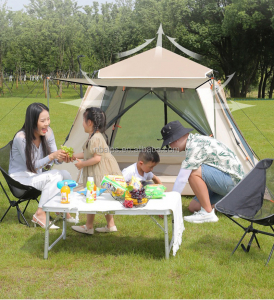News Center+ 查看更多
News Center
+ 查看更多
Durability Matters: Materials That Make the Best Camping Tents+ 查看更多
Durability Matters: Materials That Make the Best Camping Tents
+ 查看更多
Date:2023-12-17
Selecting a durable camping tent involves understanding the materials that contribute to its resilience in various outdoor conditions. The choice of fabric, poles, stitching, and coatings significantly impacts a tent's durability and longevity.
1. Tent Fabrics and Strength
Tent fabrics vary in strength and weather resistance. Common materials include nylon, polyester, canvas, and specialized fabrics like ripstop or silnylon. Nylon and polyester offer a balance between weight and durability. Canvas, though heavier, provides exceptional durability and insulation. Ripstop fabrics prevent tears from spreading, while silnylon combines silicon and nylon for enhanced water resistance.
2. Waterproof Coatings and Weather Protection
Tents incorporate waterproof coatings to repel moisture. Polyurethane (PU) coatings are standard, providing water resistance to tent fabrics. Additionally, some tents employ silicone coatings or use factory-applied durable water repellent (DWR) treatments to enhance waterproofing, ensuring protection against rain and condensation.
3. Tent Poles and Construction
Tent poles contribute to a tent's structural integrity. Aluminum poles offer durability while being lightweight. Fiberglass poles are more budget-friendly but may lack the same level of strength. Advanced tents may use carbon fiber poles for superior strength-to-weight ratio, ideal for extreme weather conditions or ultralight backpacking.
4. Stitching and Seams
Strong stitching and seam sealing are vital for a tent's durability. Reinforced stitching, such as double stitching, prevents seams from unraveling. Taped seams or welded construction enhance water resistance, preventing leaks and ensuring a dry interior during rainy weather.
5. Zippers and Hardware
High-quality zippers and hardware contribute to a tent's overall durability. YKK zippers are renowned for their reliability and resistance to snagging. Robust hardware, such as aluminum stakes or tensioners, enhances the tent's stability in windy conditions.
6. UV Resistance and Longevity
UV exposure can degrade tent fabrics over time. Materials treated for UV resistance prolong the tent's lifespan by protecting against sun damage, ensuring the tent retains its strength and color even after prolonged exposure to sunlight.
7. Ventilation and Condensation Management
Adequate ventilation in tents minimizes condensation buildup, which can weaken fabrics and compromise durability. Tents with well-designed vents, mesh panels, and rainfly options allow airflow, reducing moisture inside the tent and contributing to its longevity.
8. User Reviews and Recommendations
Gleaning insights from user reviews aids in understanding real-world performance. Evaluating experiences shared by fellow campers provides valuable insights into a tent's durability, weather resistance, ease of setup, and overall satisfaction.
Conclusion
The durability of camping tents depends on a combination of materials, construction, and design elements. By considering fabric strength, coatings, poles, stitching, and user experiences, campers can invest in a durable tent that withstands the rigors of outdoor adventures, ensuring shelter and protection in various conditions.

